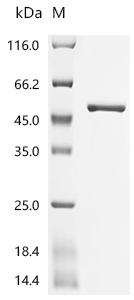Recombinant Arabidopsis thaliana Glutamine synthetase, chloroplastic/mitochondrial (GLN2) is produced in E. coli and includes the mature protein length from amino acids 46 to 430. The product contains a C-terminal 6xHis tag, which allows for straightforward purification and detection. SDS-PAGE analysis confirms purity levels above 95%, suggesting this represents high-quality protein for research work.
Glutamine synthetase, chloroplastic/mitochondrial (GLN2), appears to be a crucial enzyme in nitrogen metabolism. It catalyzes the ATP-dependent conversion of glutamate and ammonia to glutamine. This protein likely plays an important role in nitrogen assimilation—a key process for plant growth and development. Research on this enzyme may provide insights into nitrogen use pathways and how plants respond to stress, which could be significant for agricultural and environmental studies.
Potential Applications
Note: The applications listed below are based on what we know about this protein's biological functions, published research, and experience from experts in the field. However, we haven't fully tested all of these applications ourselves yet. We'd recommend running some preliminary tests first to make sure they work for your specific research goals.
Based on the provided information, the folding state and bioactivity of this recombinant GLN2 protein are unknown and cannot be assumed. Glutamine synthetase is a complex, multi-subunit enzyme that requires precise folding and often metal cofactors for activity. While the protein represents the mature sequence (46-430aa) and has high purity (>95%), expression in E. coli does not guarantee correct folding for a eukaryotic, organellar-targeted protein. The C-terminal His-tag may also potentially influence oligomerization or activity. Therefore, any application that depends on the protein's specific enzymatic activity or native quaternary structure is speculative without experimental validation.
1. Protein-Protein Interaction Studies Using His-Tag Pull-Down Assays
The C-terminal 6xHis tag allows this recombinant GLN2 to be immobilized for pull-down assays to identify potential binding partners from plant extracts. The high purity (>95%) is beneficial for reducing background. However, a critical caveat is that any interactions detected are contingent upon the recombinant protein being correctly folded and assembled into its native oligomeric state. If the protein is misfolded or cannot form proper complexes, it may not present the correct surfaces for interaction, leading to false negatives or non-specific binding. The results must be interpreted with caution and confirmed with complementary methods.
2. Antibody Development and Validation
The high-purity recombinant GLN2 protein is suitable for use as an immunogen to generate specific antibodies. The mature protein sequence increases the likelihood that antibodies will recognize the endogenous enzyme. However, it is important to note that antibodies generated will primarily recognize linear epitopes. Their ability to bind the natively folded, oligomeric, and potentially post-translationally modified GLN2 enzyme in Arabidopsis chloroplasts or mitochondria is not guaranteed and requires empirical validation (e.g., using plant tissue extracts). The recombinant GLN2 protein is excellent for initial antibody screening and validation in techniques like Western blotting.
3. Biochemical Characterization and Enzyme Kinetics Analysis
This recombinant GLN2 protein is a necessary starting point for biochemical characterization. The primary and essential first step is to subject the protein to activity assays using glutamate, ammonia, and ATP as substrates to determine if the recombinant enzyme is functional. Only if catalytic activity is confirmed can subsequent studies on kinetics, pH/temperature optima, and inhibitor sensitivity be meaningfully pursued. The high purity is a prerequisite for reliable assays, but does not substitute for activity confirmation.
4. Comparative Structural and Functional Studies
The recombinant GLN2 protein can serve as a standard for comparative studies. The viability of this application is entirely dependent on the outcome of initial activity tests. Side-by-side analysis of enzymatic properties is only possible if this protein is first shown to be active. If inactive, its utility for functional comparisons is null. However, it could still be used for comparative structural studies (e.g., circular dichroism spectroscopy) or as a standard in immunoblots across species, independent of activity.
Final Recommendation & Action Plan
The immediate and imperative first step is to perform a standard glutamine synthetase activity assay (e.g., the biosynthetic or transferase assay) to confirm the enzyme's functionality before investing resources in most proposed applications. The outcome of this test is critical: a positive result would validate the use of the protein in kinetic studies (Application 3), meaningful interaction studies (Application 1), and functional comparisons (Application 4). A negative result would limit its utility primarily to Application 2 (antibody production, with the noted caveat about native protein recognition) and non-functional comparative studies. Therefore, the activity assay is not just an option but a prerequisite for interpreting data from any functional experiment correctly.






